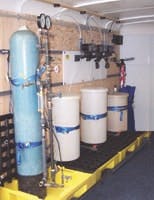A pilot test of GreensandPlus from Inversand Co. as pretreatment to an existing RO plant at a Western U.S. water utility demonstrated a dramatic reduction of iron and manganese in the raw water to levels below 15 ppb. The negative effect the iron and manganese was causing in the treatment process was eliminated. The GreensandPlus filter achieved these results operating at flux rates of up to 8 gal per minute per square foot.
Prior to the application of the GreensandPlus, an iron silicate was being formed in the RO vessel at the existing plant, thus fouling the membranes. The iron was below the MCL for potable water, but was high enough to cause fouling in the presence of the silica.
The raw water had 0.25 mg/L average iron and 0.023 mg/L average manganese. To correct the problem, the manufacturer of the membranes recommended reduction of the iron and manganese in the raw water to less than 15 ppb for each constituent.
Laboratory tests were conducted prior to the onsite study. A water sample with iron content of 0.5 to 1.0 mg/L, and manganese content of 0.06 to 0.09 mg/L, was used in the lab. A filter column loaded with GreensandPlus and anthracite was used to conduct the test. The iron content in this test was reduced to less than 0.009 mg/L, and the manganese content was reduced to less than 0.004 mg/L.
Based on these results, a pilot plant was set up and run on two different wells at the job site. At the first well, the system was operated at a flux rate of 6 gpm/sq ft of filter area. The raw water in this well had an average iron content of 0.074 mg/L and manganese content of 0.013 mg/L . After filtration, the effluent had average iron content of 0.001 mg/L, and 0.007 mg/L average manganese. Thus, the iron and manganese content was far less than the requirement set by the membrane manufacturer.
At the second well, the flux rate was increased to 8 gpm/sq ft. In this well, the average raw water iron content was 0.250 mg/L, and the average manganese content was 0.023 mg/L. After filtration through GreensandPlus and anthracite, the average iron content was reduced to 0.002 mg/L, and the manganese content to 0.008 mg/L. Despite the increase in flux, the iron and manganese content were well below the maximum allowable for the RO membranes, as specified by the membrane manufacturer.
The project is now entering the design stage for a full scale 8,000 gpm filtration system at the water utility plant.
Source: Inversand Co., Inc.


